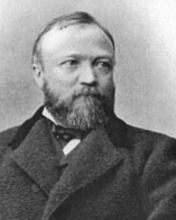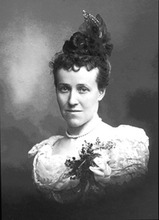

Carnegie was born on November 25, 1835, in Dunfermline, Fife, Scotland. He was the son of a hand loom weaver, William T. Carnegie. His mother, Margaret Morrison, was a daughter of Thomas Morrison, a tanner and shoemaker.
Many of Carnegies closest relatives were self-educated tradesmen and class activists. William Carnegie, although poor, had educated himself and, as far as his resources would permit, ensured that his children received an education. William Carnegie was politically active and was involved with those organizing demonstrations against the Corn laws. He was also a Chartist. He wrote frequently to newspapers and contributed articles in the radical pamphlet, Cobbetts Register edited by William Cobbett. Among other things, he argued for abolition of the rotten boroughs and reform of the British House of Commons, Catholic Emancipation, and laws governing safety at work, which were passed many years later in the Factory Acts. He promoted the abolition of all forms of hereditary privilege, including all monarchies.
Bibliography:
The Autobiography of Andrew Carnegie, by Andrew Carnegie, Houghton Mifflin Company, Boston, 1920,
Andrew Carnegie, by Joseph F. Wall, Oxford University Press, New York, 1970,
Carnegie, by Peter Krass, John Wiley & Sons, Hoboken, NJ, 2002,
Children: 1 daughter,
1.+Margaret Cameron CARNEGIE, b.30 mar.1897, m.1 Apr.1919 Roswell Miller Jr., b.16 Oct.1894,
Daughter of New York City merchant John D. Whitfield, Louise was born in the Gramercy Park neighborhood of Manhattan. She married Andrew Carnegie in a private ceremony at her familys New York City home on April 22, 1887. She was 30, Carnegie was 57. As wedding gifts from her husband, Louise received an approximate annual income of $20,000, and a home at 5 West 51st Street. [Wikipedia]
Andrew Carnegie, the millionaire author and manufacturer, was married last night to Miss Louise Whitfield, eldest daughter of John W. Whitfield, of this city, at the residence of the brides mother, 35 West Forty-eighth Street. [New York Times 23 Apr.1887 p.1:]
Obituary: On Tuesday, June 24, Mrs. Andrew Carnegie died at her home in New York City, in her eighty-ninth year. This brought to an end a long and exceptional life of great distinction and fine living. Although since the death of her husband in 1919 Mrs. Carnegie had seldom visited Pittsburgh, she was known to many here for her high purpose, kindliness, and nobility of character.
Notwithstanding the great wealth and prominence of her husband, she played her individual part in all his philanthropies as a counselor and an enthusiastic co-planner in his hopes for the betterment of the human race. She was self-effacing in her own benefactions, which were many, but fully lived up to what she felt to be the responsibilities placed upon her by her opportunities for service. A true lady in the old fashioned sense of the word, she was most gracious and kindly to all with whom she came in contact and could well be taken as an outstanding example of American womanhood.